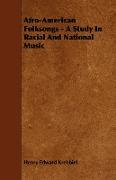Afro-American Folksongs - A Study in Racial and National Music
BücherAngebote / Angebote:
PREFACE This book was written with the purpose of bringing a species of folksong into the field of scientific observation and presenting it as fit material for artistic treatment. It is a continuation of a branch of musical studv for which the foundation was laid more than a decade age in a series of essays with bibliographical addenda printed in the New York Tribune, of which journal the author has been the musical reviewer for more than thirty years. The general subject of those articles was folksongs and their relation to national schools of composition. It had come to the writers knowledge that the articles had been clipped from the newspaper, placed in envelopes and indexed in several public libraries, and many requests came to him from librarians and students that they be republished in book- form. This advice could not be acted upon because the articles were mere outlines, ground-plans, suggestions and guides to the larger work or works which the author hoped would the be the result of his instigation. Folksong literature has grown considerably since then, especially in Europe, but the subject of paramount interest to the people of the United States has practically been ignored. The songs created by the negroes while they were slaves on the olantations of the South have cried out in vain for scientific study, though ragtime tunes, which are their debased offspring, have seized upon the fancy of the civilized world. This popularity may be deplorable, but it serves at Ieast to prove that a marvellous potency lies in the characteristic rhythmical element of the slave songs. Would not a wider and truer knowledge of their other characteristics as well lead to the creation of a better art than that which tickles the ears and stimulates the feet of the pleasure-seekers of London, Paris, Berlin and Vienna even more than it does those of New York The charm of the Afro-American songs has been widely recognized, but no musical savant has yet come to analyze them. Their two most obvious elements only have been copied by composers and dance-makers, who have wished PREFACE to imitate them. These elements are the rhythmical propulsion which comes from the initial syncopation common to the bulk of them the snap or catch which in an exaggerated form lies at the basis of ragtime and the frequent use of the five-tone or pentatonic scale. But there is much more that is characteristic in this body of melody, and this more has been neglected because it has not been uncovered to the artistic world. There has been no study of it outside of the authors introduction to the subject printed years ago and a few comments, called forth by transient phenomena, in the Tribune newspaper in the course of the last generation. This does not mean that the world has kept silent on the subject. On the contrary, there has been anything but a dearth of newspaper and platform talk about songs which the negroes sang in America when they were slaves, but most of it has revolved around the questions whether or not the songs were original creations of these native blacks, whether or not they were entitled to be called American and whether or not they were worthy of consideration as foundation elements for a school of American composition. The greater part of what has been written was the result of an agitation which followed Dr. Antonin Dvofiks efforts to direct the attention of American comoosers to the beauty and efficiency of the material which these melodies contained for treatment in the higher artistic forms. Dr...
Folgt in ca. 10 Arbeitstagen


